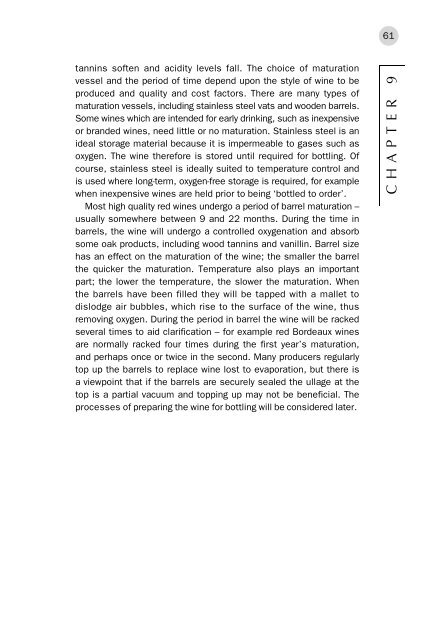Wine Production : Vine to Bottle - Vinum Vine
Wine Production : Vine to Bottle - Vinum Vine
Wine Production : Vine to Bottle - Vinum Vine
You also want an ePaper? Increase the reach of your titles
YUMPU automatically turns print PDFs into web optimized ePapers that Google loves.
61<br />
tannins soften and acidity levels fall. The choice of maturation<br />
vessel and the period of time depend upon the style of wine <strong>to</strong> be<br />
produced and quality and cost fac<strong>to</strong>rs. There are many types of<br />
maturation vessels, including stainless steel vats and wooden barrels.<br />
Some wines which are intended for early drinking, such as inexpensive<br />
or branded wines, need little or no maturation. Stainless steel is an<br />
ideal s<strong>to</strong>rage material because it is impermeable <strong>to</strong> gases such as<br />
oxygen. The wine therefore is s<strong>to</strong>red until required for bottling. Of<br />
course, stainless steel is ideally suited <strong>to</strong> temperature control and<br />
is used where long-term, oxygen-free s<strong>to</strong>rage is required, for example<br />
when inexpensive wines are held prior <strong>to</strong> being ‘bottled <strong>to</strong> order’.<br />
Most high quality red wines undergo a period of barrel maturation –<br />
usually somewhere between 9 and 22 months. During the time in<br />
barrels, the wine will undergo a controlled oxygenation and absorb<br />
some oak products, including wood tannins and vanillin. Barrel size<br />
has an effect on the maturation of the wine; the smaller the barrel<br />
the quicker the maturation. Temperature also plays an important<br />
part; the lower the temperature, the slower the maturation. When<br />
the barrels have been filled they will be tapped with a mallet <strong>to</strong><br />
dislodge air bubbles, which rise <strong>to</strong> the surface of the wine, thus<br />
removing oxygen. During the period in barrel the wine will be racked<br />
several times <strong>to</strong> aid clarification – for example red Bordeaux wines<br />
are normally racked four times during the first year’s maturation,<br />
and perhaps once or twice in the second. Many producers regularly<br />
<strong>to</strong>p up the barrels <strong>to</strong> replace wine lost <strong>to</strong> evaporation, but there is<br />
a viewpoint that if the barrels are securely sealed the ullage at the<br />
<strong>to</strong>p is a partial vacuum and <strong>to</strong>pping up may not be beneficial. The<br />
processes of preparing the wine for bottling will be considered later.<br />
CHAPTER 9
















